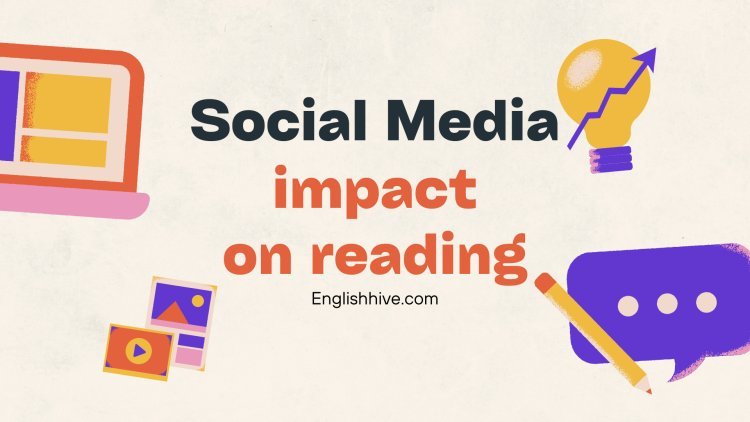The impact of social media on reading: text with comprehension exercises
Let's dive into the world of social media and its impact on reading comprehension.

Challenges of Digital Media
In today's digital age, there are numerous challenges that individuals face when it comes to reading comprehension. With the rise of digital media, there is an overwhelming amount of information available at our fingertips. However, this abundance of information can also be overwhelming and make it difficult for readers to focus and retain what they have read.
One challenge of digital media is the constant presence of distractions. Social media platforms and other online tools are designed to capture and hold our attention, making it difficult to concentrate on longer texts and engage in deep reading. Additionally, the use of hyperlinks, advertisements, and pop-ups can disrupt the reading process and divert attention away from the main text.
Increasing Influence of Social Media
Social media platforms have become an integral part of our daily lives. They not only facilitate communication and networking but also serve as a source of news and information. However, the influence of social media on reading comprehension is complex.
On one hand, social media can provide access to a diverse range of perspectives and ideas, allowing individuals to engage with different types of texts. On the other hand, social media platforms are often filled with short, condensed messages or posts that do not require deep reading or critical thinking. This can lead to a decline in the overall reading comprehension skills of individuals.
Rise of Shortened Texts on Social Media
One significant challenge in the digital age is the rise of shortened texts on social media. Platforms like Twitter and Instagram have popularized the use of character limits and image-based communication, making it difficult for individuals to engage in long-form reading.
Shortened texts often lack context and depth, making it challenging for readers to fully comprehend the intended message. Readers must decipher and infer meaning from limited information, which can result in misinterpretation or misunderstanding.
Impact of Emojis and Abbreviations on Reading Comprehension
The use of emojis and abbreviations in digital communication has become prevalent, particularly on social media platforms. While emojis and abbreviations can enhance the expression of emotions and save time in writing, they also pose challenges to reading comprehension.
Emojis, for example, may carry different meanings for different individuals, leading to misinterpretation. Abbreviations, on the other hand, may require prior knowledge or familiarity with online language, which can exclude individuals who are not accustomed to these forms of communication.
Navigating News and Fake News on Social Media
The proliferation of fake news on social media poses a significant challenge to reading comprehension. With the ease of sharing and spreading information, it becomes crucial for readers to critically evaluate and verify the reliability of the content they come across.
Readers need to develop a discerning eye and employ critical thinking skills to identify reliable sources, recognize bias, and distinguish between fact and fiction. Without these skills, readers may fall victim to misinformation and develop skewed perspectives on various issues.
Addressing Bias and Misinformation in Texts
As readers navigate digital media, they must be aware of bias and misinformation present in texts. Digital platforms often have their own agendas and may present information selectively or with a specific bias.
To overcome this challenge, readers must approach texts with a critical mindset, seeking multiple sources and perspectives to gain a comprehensive understanding. Fact-checking and triangulating information from reliable sources can help readers identify and counteract bias and misinformation.
Overcoming Distractions in a Social Media-driven World
In a social media-driven world, overcoming distractions is essential for effective reading comprehension. Readers must develop strategies to minimize interruptions and maintain focus.
One strategy is to establish dedicated reading time, away from digital distractions. Creating a quiet and calm environment can help improve concentration and comprehension. Additionally, utilizing tools such as ad-blockers and turning off notifications can limit distractions and facilitate deeper engagement with the text.
Balancing Digital and Print Reading
While digital media offers convenience and accessibility, it is essential to strike a balance between digital and print reading. Print reading allows for a more immersive experience and helps develop sustained attention and focus.
Readers should aim to incorporate both digital and print texts into their reading habits. Print reading can be reserved for more in-depth and complex texts, while digital reading can be utilized for quick information gathering and staying updated with current events.
Role of Critical Thinking in Digital Texts
Critical thinking plays a crucial role in navigating digital texts effectively. Readers must approach digital texts with a critical eye, questioning the reliability, credibility, and bias present in the information they encounter.
Critical thinking skills enable readers to evaluate the accuracy of sources, analyze arguments, and make informed judgments. By cultivating critical thinking, readers can overcome the challenges posed by digital media and enhance their reading comprehension abilities.
Fostering Healthy Reading Habits in the Digital Age
In the digital age, fostering healthy reading habits is essential for maintaining reading comprehension skills. Here are some tips to promote healthy reading habits:
1. Set aside dedicated reading time: Allocate specific time for reading without distractions.
2. Read a variety of texts: Explore different genres, topics, and formats to broaden your knowledge and reading skills.
3. Practice active reading: Engage with the text actively by asking questions, making connections, and reflecting on the material.
4. Use context clues: Develop the ability to infer meaning from the context of a text, including visual cues, tone, and surrounding information.
5. Build vocabulary: Regularly expose yourself to new words and concepts to expand your vocabulary and comprehension abilities.
6. Take effective notes: Summarize key points, highlight important details, and jot down questions or ideas while reading to enhance understanding and retention.
By adopting these habits, readers can navigate the challenges of digital media and develop stronger reading comprehension skills in the digital age.
What's Your Reaction?


















